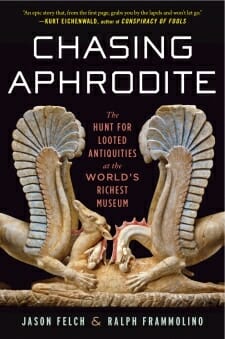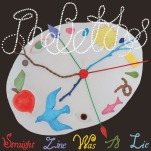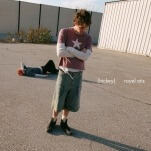Chasing Aphrodite by Jason Felch and Ralph Frammolino
The Art of Looting

“To me my works of art are all vividly alive. They’re the embodiment of whoever created them—a mirror of their creator’s hopes, dreams and frustrations. They have led eventful lives—pampered by the aristocracy and pillaged by revolution, courted with ardor and cold-bloodedly abandoned. They have been honored by drawing rooms and humbled by attics. So many worlds in their lifespan, yet all were transitory. What stories they could tell, what sights they must have seen! Their worlds have long since disintegrated, yet they live on.”—J. Paul Getty, The Collector’s Choice
Artifacts belong in museums. We know this much from Indiana Jones’ epic words at the beginning of Last Crusade, when he yells (on a sinking ship in the middle of a typhoon, no less) “That belongs in a museum!” to another explorer who wants to keep an artifact for private use.
Indy, a rarely equaled hero whose archetype has knocked some of the dust off archaeology as a career calling, was honorably advocating museums over private collections, looking out for those estimable institutions of the public good.
Well … most times estimable.
Chasing Aphrodite is an unsettling read. It calls into question the unique place museums occupy in our society … and the privilege, admiration, and virtue usually associated with them.
In general, we consider those who fill our museums to be selfless philanthropists, men and women who spend large sums of private money so the public can enjoy rare art and antiquities. These benefactors help us maintain a level of culture in society, a sense of history within mankind, and other such boons of civilization. Some among us can even feel guilty for not visiting museums often enough, a feeling akin to the one arising from failing to visit one’s grandparents.
For such reasons, it hits home when a museum allegedly acts as unscrupulously as a criminal organization (or a Wall Street institution). According to authors Felch and Frammolino in their fascinating book, “white-gloved curators” at the world-famous J. Paul Getty Museum in Los Angeles “did business with criminals.” The authors claim that, in the process, the Getty destroyed far more history than it preserved.
Chasing Aphrodite reads like an overblown thriller. The wealthiest man on the planet, J. Paul Getty, keeps track of his money down to the most trivial daily purchases. His one guilty pleasure? Buying art. Getty actually hates himself for this compulsion, considering it an addiction and a curse. Nevertheless, he succumbs, perhaps because even through his stinginess he can appreciate the significance of the artifacts.
Getty founds a small, eponymous museum in California, mostly for its tax benefits. The museum remains mediocre until Getty dies and bequeaths it $700 million, making the Getty the richest museum in the world overnight.
The museum hires a Communist refugee curator, who comes up with an elaborate scheme that lets his wealthy Hollywood friends receive exorbitant tax benefits by donating antiquities they buy from illicit dealers. As a result, the museum’s basement fills to the brim with random artifacts of uncertain value, none of which have any paperwork of origin.
On the other side of the world, a young Italian investigator on a team of old-timers tries to figure out why artifacts of Italian origin keep popping up all over the world (mostly America, and most often of all at a certain museum in Southern California). He spends months looking over the case files, almost giving up … and then he notices a tiny piece of paper. It turns out to be a sales receipt that cracks the case.
-

-

-

-

-

-

-

-

-

-

-

-

-

-

-

-

-

-

-

-

-

-

-

-

-

-

-

-

-

-

-

-

-

-

-

-

-

-

-

-








































